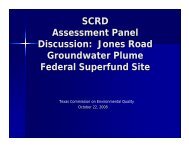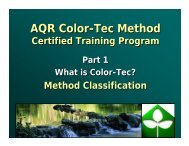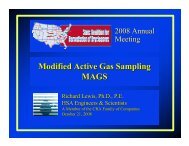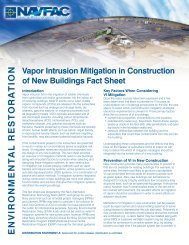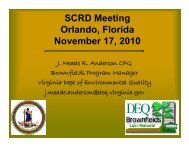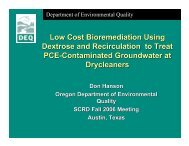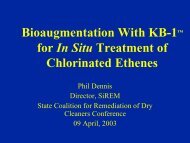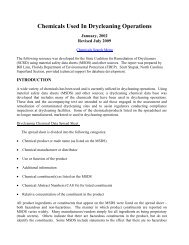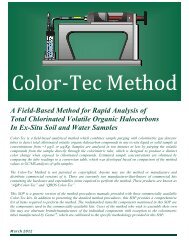Case Study - Fielder Plaza Site, Arlington, Texas
Case Study - Fielder Plaza Site, Arlington, Texas
Case Study - Fielder Plaza Site, Arlington, Texas
You also want an ePaper? Increase the reach of your titles
YUMPU automatically turns print PDFs into web optimized ePapers that Google loves.
<strong>Case</strong> <strong>Study</strong> - <strong>Fielder</strong> <strong>Plaza</strong> <strong>Site</strong>,<br />
<strong>Arlington</strong>, <strong>Texas</strong><br />
Remedy Standard Selection and Presumptive<br />
Remedy Screening<br />
• Richard Scharlach. . P.G.<br />
• Technical Specialist<br />
• <strong>Texas</strong> Commission on<br />
Environmental Quality<br />
N<br />
o<br />
v<br />
SCRD November 2009<br />
November 19, 2009
<strong>Case</strong> <strong>Study</strong> - <strong>Fielder</strong> <strong>Plaza</strong> - Outline<br />
• <strong>Site</strong> Location and History<br />
• <strong>Site</strong> Assessment Results<br />
• Regional and <strong>Site</strong> Geology<br />
• <strong>Texas</strong> Risk Reduction Program (TRRP)<br />
• Groundwater Classification and Remedy<br />
Standards<br />
• Goals for FY2010<br />
SCRD November 2009
<strong>Fielder</strong> <strong>Plaza</strong> <strong>Site</strong> – <strong>Arlington</strong> <strong>Texas</strong><br />
• <strong>Arlington</strong> is located in Tarrant County.<br />
• Suburban Dallas / Fort Worth area<br />
SCRD November 2009
Aerial View of <strong>Fielder</strong> <strong>Plaza</strong> and<br />
Surrounding Area<br />
SCRD November 2009
<strong>Fielder</strong> <strong>Plaza</strong> Results of Receptor<br />
Survey<br />
SCRD November 2009
Aerial View of <strong>Fielder</strong> <strong>Plaza</strong><br />
Shopping Center<br />
SCRD November 2009
<strong>Fielder</strong> <strong>Plaza</strong> - <strong>Site</strong> History<br />
• Two former Perc-using Dry Cleaner facilities<br />
-Oak Cleaners /fmr Comet 1 Hr. ( operated1975 –<br />
2004)<br />
-Val-U Cleaners ( operated 1992 – 2005)<br />
• Both are now operating as drop stations.<br />
SCRD November 2009
<strong>Fielder</strong> <strong>Plaza</strong> Shopping Center –<br />
Two Former Dry Cleaner Locations<br />
SCRD November 2009
<strong>Fielder</strong> <strong>Plaza</strong> - <strong>Site</strong> History (Cont’d)<br />
• Extensive <strong>Site</strong> Assessment History (15 years)<br />
• Groundwater assessment completed<br />
• Soil Contamination only at the Comet 1 Hr.<br />
/Oak Cleaners<br />
• Only Tetrachloroethylene (PCE) and<br />
Trichloroethylene (TCE) detected<br />
• One Source or Two<br />
SCRD November 2009
<strong>Fielder</strong> <strong>Plaza</strong> -Soil Data<br />
Chemicals of Concern<br />
(COCs)<br />
Greatest<br />
Concentration<br />
Observed (mg/Kg)<br />
Depth<br />
(ft.)<br />
Boring/Well<br />
Observed<br />
Sample<br />
Date<br />
Tetrachloroethylene<br />
(PCE)<br />
57.3<br />
4<br />
B-1<br />
8/2/1999<br />
Trichloroethylene (TCE)<br />
3.01<br />
3-4<br />
B-2<br />
8/2/1999<br />
Cis-1,2<br />
1,2-<br />
dichloroethylene<br />
<strong>Fielder</strong> <strong>Plaza</strong> – Soil Data Points<br />
SCRD November 2009
<strong>Fielder</strong> <strong>Plaza</strong> - Groundwater Data<br />
Chemicals of<br />
Concern (COCs)<br />
GW GW ING PCL<br />
(mg/L)<br />
Greatest<br />
Concentration<br />
Observed (mg/L)<br />
Well Observed<br />
Date Observed<br />
Tetrachloroethylene<br />
(PCE)<br />
0.005<br />
0.447<br />
MW-14S<br />
12/19/2000<br />
Trichloroethylene<br />
(TCE)<br />
0.005<br />
0.0055<br />
MW-9<br />
6/30/2008<br />
Cis-1,2<br />
1,2-<br />
dichloroethylene<br />
0.07<br />
0.0013<br />
MW-27<br />
1/8/2008<br />
Trans-1,2<br />
1,2-<br />
dichloroethylene<br />
0.1<br />
GroundWater PCLE Excedence<br />
Zone<br />
SCRD November 2009
Regional Geology<br />
• <strong>Site</strong> Geologic Setting:<br />
Top 0 – 10 feet is Navo-Urban loam and clay soils.<br />
Surface soils are underlain by the outcrop of the<br />
Woodbine Formation, which ranges in thickness<br />
from 200 to 250 feet regionally.<br />
The Woodbine aquifer is a minor aquifer of <strong>Texas</strong>,<br />
which was once a historic water supply source for<br />
the City of <strong>Arlington</strong>.<br />
SCRD November 2009
Regional Geologic Map<br />
SCRD November 2009
<strong>Fielder</strong> <strong>Plaza</strong> - Cross Section Location<br />
SCRD November 2009
<strong>Site</strong> Cross Section<br />
SCRD November 2009
<strong>Texas</strong> Risk Reduction Program<br />
Ground Water Classification and Remedy Standards<br />
TRRP Groundwater<br />
Classification<br />
Class 1 Primary Resource<br />
Class 2 Potential Resource<br />
Class 3 Non-Potential Resource<br />
Definition*<br />
-Impact to PWS possible,<br />
-GW unit is only reliable source<br />
< 800 ft bgs<br />
-High yield and low TDS<br />
-Moderate yield and TDS<br />
Low Yield or High TDS<br />
Groundwater Cleanup<br />
Level<br />
Drinking Water Standards<br />
Drinking Water Standards.<br />
Plume Management Zone<br />
(PMZ) Allowed.<br />
100xDrinking Water Standards.<br />
PMZ allowed.<br />
Not a Groundwater-Bearing<br />
Unit<br />
K < 1 x 10-<br />
-5 cm/sec<br />
K < 1 x 10<br />
cm/sec<br />
Drinking Water Standards do<br />
not apply.<br />
SCRD November 2009
TRRP Groundwater Classification<br />
at <strong>Fielder</strong> <strong>Plaza</strong> (Woodbine Aquifer)<br />
• TRRP Groundwater Class 2<br />
• Basis for Groundwater Classification<br />
• Water Quantity: Well Yield 5,000 to 25,000 gpd.<br />
• Water Quality: TDS
TRRP GW Classification and<br />
Remedy Standards at <strong>Fielder</strong> <strong>Plaza</strong><br />
TRRP Groundwater<br />
Classification<br />
Class 1 Primary Resource<br />
Class 2 Potential<br />
Resource<br />
Class 3 Non-Potential<br />
Resource<br />
Definition*<br />
-Impact to PWS possible,<br />
-GW unit is only reliable source <<br />
800 ft bgs<br />
-High yield and low TDS<br />
-Moderate yield and<br />
TDS<br />
Low Yield or High TDS<br />
Groundwater Cleanup<br />
Level<br />
Drinking Water Standards<br />
Drinking Water<br />
Standards<br />
Plume Management<br />
Zone (PMZ) Allowed<br />
100xDrinking Water Standards.<br />
PMZ allowed<br />
Not a Groundwater-Bearing<br />
Unit<br />
Hydaulic Conductivity < 1 x 10<br />
cm/sec<br />
Conductivity < 1 x 10-<br />
-5<br />
SCRD November 2009<br />
Drinking Water Standard do not<br />
apply.
TRRP Remedy Standards Options<br />
• Remedy Standard A –<br />
Decontamination.<br />
Cleanup to Drinking Water Standards<br />
• Remedy Standard B - Closure with<br />
Controls.<br />
Controls. (e.g. Engineered Caps, Land Use<br />
Restrictions, Plume Management Zone PMZ)<br />
SCRD November 2009
Plume Management Zone (PMZ)<br />
Plume Management Zone – a defined area and<br />
depth interval within which institutional controls<br />
are applied to prevent human contact with<br />
affected groundwater. This effectively removes<br />
the groundwater ingestion pathway from<br />
consideration inside the PMZ.<br />
SCRD November 2009
Plume Management Zones – What’s<br />
Required<br />
•Detailed Requirements for Implementation<br />
of a PMZ<br />
•Maximum Allowable Size of a PMZ<br />
•Must be a Contingency Plan in place to<br />
implement addition response actions if plume<br />
is expanding.<br />
SCRD November 2009
TRRP Remedy Standards Options at<br />
• Remedy Standard A:<br />
<strong>Fielder</strong> <strong>Plaza</strong><br />
‣ Cleanup Entire Plume to Drinking Water Standards<br />
• Remedy Standard B:<br />
‣ Establish PMZ for Entire Plume<br />
‣ Establish PMZ for Onsite Portion of Plume and<br />
Cleanup Offsite Portion of Plume to Drinking Water<br />
Standards<br />
SCRD November 2009
Plume Management Zone – Option 1<br />
SCRD November 2009
Plume Management Zone – Option 2<br />
• Include PMZ map with only half of plume in<br />
PMZ<br />
SCRD November 2009
Is Remediation Required if PMZ is<br />
Implemented<br />
• Even if PMZ is implemented – soil and<br />
groundwater remediation will still be required.<br />
SCRD November 2009
<strong>Fielder</strong> <strong>Plaza</strong> - Presumptive Soil<br />
Remedy Options<br />
• In-Situ Chemical Oxidation<br />
• Excavation<br />
• Soil Vapor Extraction<br />
SCRD November 2009
Soil Remedy Options – removed<br />
from consideration<br />
• In-Situ Chemical Oxidation and<br />
Excavation are<br />
are removed from consideration<br />
since most of the affected soils are beneath the<br />
occupied building.<br />
SCRD November 2009
Soil Remedies Selected<br />
• Soil Vapor Extraction:<br />
SVE remediation is recommended at this site<br />
based upon:<br />
• The relatively high permeablility soils (sandy clay<br />
/ fine sand)<br />
SCRD November 2009
Presumptive<br />
Ground Water Remedy Options<br />
• Long Term Monitoring (required for PMZ)<br />
• Bioremediation / Biostimulation<br />
• Permeable Reactive Barriers<br />
• Pump & Treat<br />
SCRD November 2009
Groundwater Remedies – Long<br />
Term Monitoring<br />
• Long-term Monitoring:<br />
Given the relatively large plume and low concentrations of PCE<br />
in groundwater samples, the designation of a Plume<br />
Management Zone (PMZ) and the continued long-term<br />
monitoring of the groundwater are warranted.<br />
SCRD November 2009
Groundwater Remedies –<br />
Bioremediation / Biostimulation<br />
• Bioremediation/Biostimulation<br />
Biostimulation: Based on the<br />
geochemical profiling ( pH, Redox Potential, Dissolved<br />
Oxygen, etc.), the groundwater for this site is not favorable<br />
for natural biodegradation,<br />
• However, the reducing conditions of the aquifer can<br />
possibly be made favorable through Biostimulation.<br />
• Pilot Test Planned for FY10 – Injection of polylactate<br />
biostimulant upgradient of Val-U Cleaners.<br />
SCRD November 2009
Groundwater Remedies –<br />
Contingencies<br />
• Permeable Reactive Barriers (PRBs(<br />
PRBs):<br />
): Could be employed to<br />
mitigate and impede migration of contaminant plumes to the adjacent downgradient<br />
residential area.<br />
• Pump and Treat: As a hydraulic control option<br />
As a hydraulic control option or alternatively, a<br />
extracted groundwater could be extracted, amended with low cost<br />
biostimulants, and re-injected into the formation through an infiltration<br />
trench.<br />
SCRD November 2009
Next Steps – Goals for FY10<br />
• GW Sampling<br />
Perform periodic sampling for COCs and MNA parameters at existing and<br />
new monitoring wells.<br />
• SVE Pilot Testing<br />
For Soil Contamination, conduct pilot test to evaluate the effectiveness and<br />
scalability of SVE for the site.<br />
• Bio-Stimulation Pilot Testing<br />
For Groundwater Contamination, conduct pilot test using HRC-X, and<br />
evaluate long-term influence to down gradient groundwater.<br />
• Sentinel Well Needed<br />
Well #28 will be used to evaluate potential plume migration towards a nearby<br />
residential pond.<br />
SCRD November 2009





